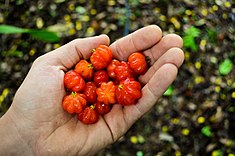Surinam cherry
| Surinam cherry | |
|---|---|
 |
|
| Scientific classification | |
| Kingdom: | Plantae |
| (unranked): | Angiosperms |
| (unranked): | Eudicots |
| (unranked): | Rosids |
| Order: | Myrtales |
| Family: | Myrtaceae |
| Genus: | Eugenia |
| Species: | E. uniflora |
| Binomial name | |
|
Eugenia uniflora L. |
|
| Synonyms | |
|
List
|
|
| Nutritional value per 100 g (3.5 oz) | |
|---|---|
| Energy | 138 kJ (33 kcal) |
|
7.49 g
|
|
|
0.4 g
|
|
|
0.8 g
|
|
| Vitamins | |
| Vitamin A equiv. |
(9%)
75 μg |
| Thiamine (B1) |
(3%)
0.03 mg |
| Riboflavin (B2) |
(3%)
0.04 mg |
| Niacin (B3) |
(2%)
0.3 mg |
| Vitamin C |
(32%)
26.3 mg |
| Minerals | |
| Calcium |
(1%)
9 mg |
| Iron |
(2%)
0.2 mg |
| Magnesium |
(3%)
12 mg |
| Phosphorus |
(2%)
11 mg |
| Potassium |
(2%)
103 mg |
| Sodium |
(0%)
3 mg |
|
|
|
|
|
| Percentages are roughly approximated using US recommendations for adults. Source: USDA Nutrient Database |
|
Eugenia uniflora, with common names Pitanga, Suriname cherry,Brazilian cherry,Cayenne cherry, or Cerisier Carré is a plant in the family Myrtaceae, native to tropical South America’s east coast, ranging from Suriname, French Guiana to southern Brazil, as well as parts of Paraguay, Argentina and Uruguay. Known as pitanga throughout Brazil and Uruguay, or ñangapirí in surrounding countries, the plant is relatively pest resistant, easy to grow and high in antioxidants. The tree is also grown in the West Indies, specifically in Haiti, where it is known as Cerisier Carré, as is in French Guiana. The Suriname cherry is often used in gardens as a hedge or screen. The tree was introduced to Bermuda for ornamental purposes but is now out of control and listed as an invasive species. In Suriname this cherry is known as Monkimonki Kersie, also Montjimontji Kersie. The tree has also been introduced to Florida.
Eugenia uniflora is a large shrub or small tree with a conical form, growing slowly to 8 meters in height. When bruised, crushed or cut, the leaves and branches have a spicy resinous fragrance, which can cause respiratory discomfort in susceptible individuals. New leaves are bronze, copper or coppery-pinkish in color, maturing to a deep glossy green, up to 4 cm long. During winter the leaves turn red.
Flowers have four white petals and are borne on slender long stalks, with a conspicuous central cluster of white stamens ending in yellow anthers. Flowers develop into ribbed fruits 2 to 4 cm in diameter, starting out as green, then ranging through orange, scarlet and maroon as they ripen.
The edible fruit is a botanical berry. The taste ranges from sweet to sour, depending on the cultivar and level of ripeness (the darker red to black range is quite sweet, while the green to orange range is strikingly tart). Its predominant food use is as a flavoring and base for jams and jellies. The fruit is high in vitamin C and a source of vitamin A.
...
Wikipedia
